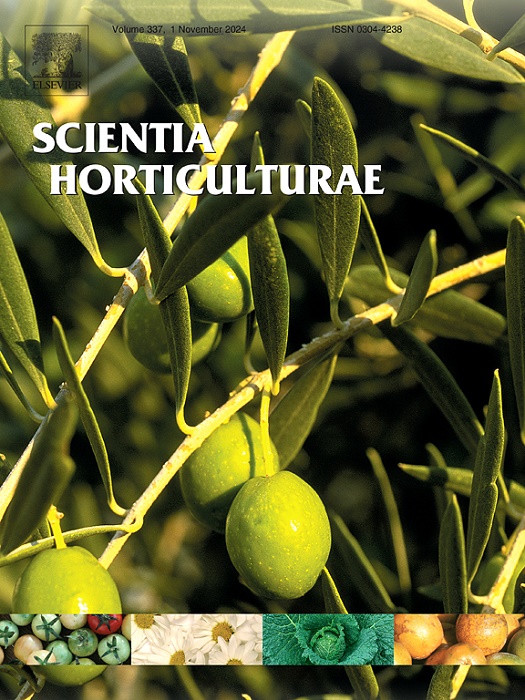Effect of grafting on Cd tolerance and accumulation characteristics of cucumber
IF 3.9
2区 农林科学
Q1 HORTICULTURE
引用次数: 0
Abstract
Currently, greenhouse soil has cadmium (Cd) pollution problems, causing serious Cd accumulation in various crops, including cucumber. Grafting is now widely used in greenhouse cucumber production, but the role and mechanism of grafting in regulating Cd accumulation and tolerance of cucumber merits further investigated. We used popular planted cucumber varieties ‘Jinchun No 4’ (Cj) and ‘Lvguan’ (Cl) as scions and the pumpkin varieties ‘Yemu Yixiong’ (Py) and ‘Jingangzuan F1’ (Pj), which are characterized by strong tolerance, weak absorption and low transport capacity of Cd, as rootstocks, to investigate the effect of grafting on Cd tolerance and accumulation in cucumber and its mechanism. Compared with self-rooted cucumber, cucumber grafted onto Py and Pj rootstocks exhibited significantly reduced Cd concentrations in scions and fruits, with improved biomass and fruit quality. There was a slight reduction in Cd concentrations in scions after self-grafting compared to self-rooted cucumber, and this reduction was more significant when Pj was the rootstock. Thus, the reduction effect of grafting was mainly dominated by rootstock effects. Grafting significantly increased the proportions of cell wall Cd, pectate- and protein-bound Cd (FNaCl), and undissolved phosphate-sequestrated Cd (FHAc) of cucumber, whereas it decreased the proportions of Cd in the soluble fractions and organelles as well as inorganic (FE) and water-soluble (FW) Cd. Therefore, grafting cucumber onto ‘Jingangzuan F1’ and ‘Yemu Yixiong’ alleviated Cd accumulation and improved Cd tolerance of cucumber by increasing compartmentalization of Cd in cell walls and promoting conversion of Cd to low-toxicity forms.
嫁接对黄瓜耐镉及积累特性的影响
目前,温室土壤存在镉(Cd)污染问题,在包括黄瓜在内的多种作物中镉积累严重。嫁接在温室黄瓜生产中已得到广泛应用,但嫁接在调节黄瓜Cd积累和耐性中的作用和机制有待进一步研究。以黄瓜品种‘金春4号’(Cj)和‘绿冠’(Cl)为接穗,以耐Cd性强、吸收能力弱、运输能力低的南瓜品种‘野木一雄’(Py)和‘京港尊F1’(Pj)为砧木,研究嫁接对黄瓜耐Cd和Cd积累的影响及其机制。与自根黄瓜相比,嫁接在Py和Pj砧木上的黄瓜接穗和果实中Cd浓度显著降低,生物量和果实品质均有显著提高。与自根黄瓜相比,自嫁接后接穗中Cd浓度略有降低,且以Pj为砧木时降低幅度更大。因此,嫁接的减量效果主要受砧木效应的支配。嫁接显著提高了黄瓜细胞壁Cd、果胶和蛋白结合Cd (FNaCl)和未溶解磷酸盐固存Cd (FHAc)的比例,降低了可溶性部分和细胞器中Cd的比例以及无机(FE)和水溶性(FW) Cd的比例。嫁接到‘京港专F1’和‘野木一雄’上的黄瓜通过增加Cd在细胞壁的区隔化和促进Cd向低毒形态的转化,减轻了Cd的积累,提高了黄瓜的Cd耐受性。
本文章由计算机程序翻译,如有差异,请以英文原文为准。
求助全文
约1分钟内获得全文
求助全文
来源期刊

Scientia Horticulturae
农林科学-园艺
CiteScore
8.60
自引率
4.70%
发文量
796
审稿时长
47 days
期刊介绍:
Scientia Horticulturae is an international journal publishing research related to horticultural crops. Articles in the journal deal with open or protected production of vegetables, fruits, edible fungi and ornamentals under temperate, subtropical and tropical conditions. Papers in related areas (biochemistry, micropropagation, soil science, plant breeding, plant physiology, phytopathology, etc.) are considered, if they contain information of direct significance to horticulture. Papers on the technical aspects of horticulture (engineering, crop processing, storage, transport etc.) are accepted for publication only if they relate directly to the living product. In the case of plantation crops, those yielding a product that may be used fresh (e.g. tropical vegetables, citrus, bananas, and other fruits) will be considered, while those papers describing the processing of the product (e.g. rubber, tobacco, and quinine) will not. The scope of the journal includes all horticultural crops but does not include speciality crops such as, medicinal crops or forestry crops, such as bamboo. Basic molecular studies without any direct application in horticulture will not be considered for this journal.
 求助内容:
求助内容: 应助结果提醒方式:
应助结果提醒方式:


